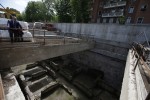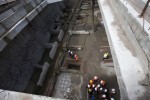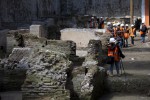 Construction of Rome’s third subway line, Metro Line C, has made a sensational discovery: the remains of a 2nd century Praetorian Guard barracks. Thirty feet under Via Ipponio between the Baths of Caracalla and the Basilica of St. John in Lateran in the historic center of Rome, the barracks cover an astonishing 1,753 square meters (18,870 square feet) of surface area (ed note: the AP story says it’s 900 sq meters, but all of the Italian press reports the larger figure so I’m going with their data), and that’s just what’s been exposed thus far. They were built during the reign of the Emperor Hadrian (117-138 A.D.), only to be demolished just over a century later during construction of the Aurelian Walls (271-275 A.D.). The demolition was thankfully half-assed, leaving impressive ruins — the walls are up to five feet high — which were then buried.
Construction of Rome’s third subway line, Metro Line C, has made a sensational discovery: the remains of a 2nd century Praetorian Guard barracks. Thirty feet under Via Ipponio between the Baths of Caracalla and the Basilica of St. John in Lateran in the historic center of Rome, the barracks cover an astonishing 1,753 square meters (18,870 square feet) of surface area (ed note: the AP story says it’s 900 sq meters, but all of the Italian press reports the larger figure so I’m going with their data), and that’s just what’s been exposed thus far. They were built during the reign of the Emperor Hadrian (117-138 A.D.), only to be demolished just over a century later during construction of the Aurelian Walls (271-275 A.D.). The demolition was thankfully half-assed, leaving impressive ruins — the walls are up to five feet high — which were then buried.
 There are 39 rooms, each four by four meters (13 x 13 feet), that open onto a central hallway. Some of the rooms, likely the officers’ quarters, are richly decorated with mosaic floors and frescoed walls. The bricks in the walls bear the stamp of the imperial kilns from 123 and 136 A.D., which is how the structure was dated. There’s also a mass grave on the site. So far 13 skeletons have been excavated from it and a few artifacts including a bronze coin and a bronze bracelet.
There are 39 rooms, each four by four meters (13 x 13 feet), that open onto a central hallway. Some of the rooms, likely the officers’ quarters, are richly decorated with mosaic floors and frescoed walls. The bricks in the walls bear the stamp of the imperial kilns from 123 and 136 A.D., which is how the structure was dated. There’s also a mass grave on the site. So far 13 skeletons have been excavated from it and a few artifacts including a bronze coin and a bronze bracelet.
 A number of military remains have been discovered in the neighborhood. Under St. John in Lateran is the Castra Nova Equitum Singularium (built under Septimius Severus, ca. 200 A.D.), a couple of blocks northeast under Via Tasso is the Castra Priora Equitum Singularium (Trajan, ca. 100 A.D.), and west of that near the church of Santo Stefano Rotondo is the Castra Peregrina (Augustus, 1st century A.D.).
A number of military remains have been discovered in the neighborhood. Under St. John in Lateran is the Castra Nova Equitum Singularium (built under Septimius Severus, ca. 200 A.D.), a couple of blocks northeast under Via Tasso is the Castra Priora Equitum Singularium (Trajan, ca. 100 A.D.), and west of that near the church of Santo Stefano Rotondo is the Castra Peregrina (Augustus, 1st century A.D.).
 Work on Metro Line C began in 2007 and has been beset by funding problems, corruption scandals and wonderful but expensive and time-consuming archaeological discoveries. While the subway tunnels themselves have been dug 80 feet below the surface to avoid hitting constant ancient roadblocks, the new stations can’t avoid bumping into thousand of years of history. The barracks site was discovered during construction of the Amba Aradam station and the city authorities tried to keep the news under wraps to avoid having to announce work on the line was suspended yet again.
Work on Metro Line C began in 2007 and has been beset by funding problems, corruption scandals and wonderful but expensive and time-consuming archaeological discoveries. While the subway tunnels themselves have been dug 80 feet below the surface to avoid hitting constant ancient roadblocks, the new stations can’t avoid bumping into thousand of years of history. The barracks site was discovered during construction of the Amba Aradam station and the city authorities tried to keep the news under wraps to avoid having to announce work on the line was suspended yet again.
 The newspaper Il Tempo broke the news of the find last Wednesday, publishing a story complete with quotations from a letter about the find written by Francesco Prosperetti, Special Superintendent for the Archaeological Area of Rome. In the letter Prosperetti describes the discovery as exceptional and in such a good state of conservation that it would not be possible to pursue the idea of dismantling it, finishing construction and then rebuilding the structure in its original context. The barracks complex is so large it occupies the entire southern half of the station and extends beyond it. The northern half of the station is also replete with archaeological remains that haven’t been explored so it’s not known at the moment what they are or the impact they’ll have. As for how so large and complete an ancient structure could have been missed by preventative archaeology done on the site before construction began, Prosperetti notes that archaeologists took core samples which pointed to ancient boundaries under a massive modern structure, but they were buried so deep underground it wasn’t possible to explore them in the preliminary stages.
The newspaper Il Tempo broke the news of the find last Wednesday, publishing a story complete with quotations from a letter about the find written by Francesco Prosperetti, Special Superintendent for the Archaeological Area of Rome. In the letter Prosperetti describes the discovery as exceptional and in such a good state of conservation that it would not be possible to pursue the idea of dismantling it, finishing construction and then rebuilding the structure in its original context. The barracks complex is so large it occupies the entire southern half of the station and extends beyond it. The northern half of the station is also replete with archaeological remains that haven’t been explored so it’s not known at the moment what they are or the impact they’ll have. As for how so large and complete an ancient structure could have been missed by preventative archaeology done on the site before construction began, Prosperetti notes that archaeologists took core samples which pointed to ancient boundaries under a massive modern structure, but they were buried so deep underground it wasn’t possible to explore them in the preliminary stages.
 The subway company now has to figure out how to proceed, and however they go about this, it’s likely going to cost time and money. Metro Line C is already the most expensive subway construction project in history. In a press conference Monday, Prosperetti gave assurances that both the great archaeological importance of the find and the Metro budget and deadlines would be respected. The plan is to integrate the ruins into the station, creating the first fully fledged “archaeological station” in Rome, all without extra expense or delays. If that sounds less than entirely believable to you, that’s because it is.
The subway company now has to figure out how to proceed, and however they go about this, it’s likely going to cost time and money. Metro Line C is already the most expensive subway construction project in history. In a press conference Monday, Prosperetti gave assurances that both the great archaeological importance of the find and the Metro budget and deadlines would be respected. The plan is to integrate the ruins into the station, creating the first fully fledged “archaeological station” in Rome, all without extra expense or delays. If that sounds less than entirely believable to you, that’s because it is.